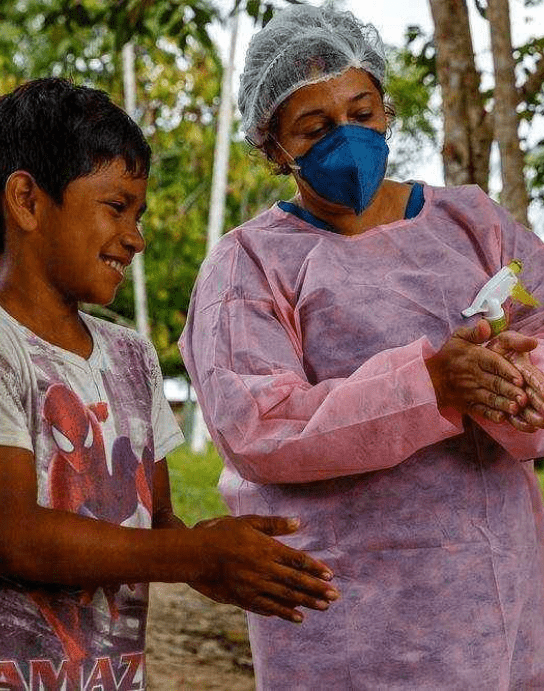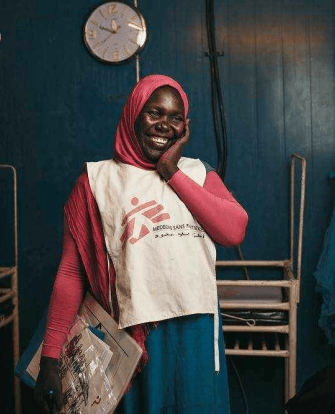
Kenya 2021 © Paul Odongo/MSF
Diabetes
An estimated 422 million people around the world have diabetes. The majority are in low- and middle-income countries, where access to affordable treatment is extremely limited—putting lives on the line.
Putting diabetes in context
Diabetes is a chronic noncommunicable disease that occurs when the body does not produce enough insulin—a hormone that regulates blood sugar (glucose)—or cannot adequately use it. There are two main types of diabetes: type 1 diabetes, in which the pancreas cannot produce any or enough insulin, and the more common type 2 diabetes, which occurs when the body is resistant to insulin or cannot produce enough. Type 2 diabetes primarily affects adults, but we’re seeing it more often in adolescents and young adults. Diabetes can be deadly if left untreated, and in recent years there has been an increase in mortality rates, especially in low- and middle-income countries.
Access to affordable treatments, including insulin, is vital to the survival of people with the disease. However, very little care is provided by government health systems, especially for type 1 diabetes, which is wholly dependent on replacing insulin, resulting in higher rates of mortality and complications in those who survive. In 2021, the life expectancy of a 10-year-old child with type 1 diabetes was 65 years old in high-income countries, and just 13 years old in low-income countries.
of people who need insulin in the world do not have access to it.
people died from diabetes in 2019, increasing by 70% since 2000.
premature deaths from diabetes could be prevented by improving diabetes diagnosis and access to essential medicine.

How MSF responds to diabetes
MSF's goal is to maximize patient empowerment and autonomy through home-based insulin and self-monitoring blood sugar. We aim to address barriers to accessing this care in the places we work.
Diabetes consultations have increased each year in our projects around the world. The range of contexts we serve is broad, including South Asia, the Middle East, and Africa. In some places, staff and patients are more familiar with diabetes and there is greater precedent to use tools like insulin pens and home glucometers, though refugees and other vulnerable groups remain excluded from access. In others, there is an even wider gap in awareness and treatment. Most MSF projects struggle to provide adequate resources and training to provide minimum standard of care for type 1 diabetes, and despite interest from the projects to introduce new oral type 2 diabetes drugs, the costs remain too high.
Facts about diabetes
Diabetes symptoms include: Blurred vision, lethargy, unintentional weight loss, extreme thirst, and frequent need to urinate.
Diabetes symptoms include:
- Blurred vision
- Lethargy
- Unintentional weight loss
- Extreme thirst
- Frequent need to urinate
Symptoms can come on suddenly or, in the case of type 2 diabetes, go unnoticed for many years. Without adequate treatment, diabetes can lead to strokes, heart attacks, kidney failure, permanent vision loss, and damage to blood vessels and nerves. Poor blood flow to the lower extremities, such as the feet or lower legs, can result in amputation.
Barriers to accessing diabetes care include a lack of resources and training to provide a minimum standard of care, insufficient monitoring systems, and limited capacity to improve insulin regimens.
Barriers to accessing diabetes care include a lack of resources and training to provide a minimum standard of care, insufficient monitoring systems, and limited capacity to improve insulin regimens.
People living with insulin-dependent diabetes rely on insulin replacement and blood sugar self-monitoring, yet these are often unavailable or inaccessible in low-resource settings. In these settings, insulin is usually administered in vials with syringes instead of insulin pens, which are more common in high-income countries and are preferred by patients because they are easier to use, less painful, and less associated with stigma.
Instead, most patients in the places MSF works are expected to go to outpatient facilities twice a day for insulin injections. People often have to travel significant distances to access the closest facility, sometimes by foot, so this disruption has an impact on their ability to go to school or work.
This is also the absolute minimum number of times per day required to manage type 1 diabetes, though in high income countries the standard is to follow a highly tailored regimen of insulin throughout the day corresponding to their diet and physical activity. In order to provide these kinds of insulin regimens, people need to be able to self-inject insulin at home, and both patients and clinicians need to know the patients’ blood sugar levels throughout the day as they go about their usual activities. Because self-monitoring of blood sugar is almost completely inaccessible in low- and middle-income countries, largely due to cost, there is no such visibility, which makes it difficult to find a safe, effective insulin dose.
Type 2 diabetes treatment usually starts with oral medication since the person is still producing insulin but they are becoming less sensitive to it. Without early management of the disease, it can progress to the insulin-dependent form. The first-line treatment for type 2 diabetes is a medication called Metformin, which is somewhat accessible in low- and middle-income countries, but there are many more options in high-income countries, where treatment has greatly expanded in recent years to include new classes of medications that help control blood sugar levels and actively protect organs like the kidneys. These medications serve a vital role is controlling blood sugar, preventing complications, and preventing the need to start insulin.
Patients with type 2 diabetes are often highly resistant to starting insulin because of shame, stigma, and the practical or logistical challenges associated with it. However, these crucial medications are almost completely inaccessible in places where MSF works due to the cost, resulting in more patients with complications and more patients navigating the transition to insulin.
Screening and diagnosis for diabetes is usually done through periodic fasting, blood sugar checks, or a Hemoglobin A1c (HbA1c) test, which must be conducted in a laboratory.
Screening and diagnosis for diabetes is usually done through periodic fasting, blood sugar checks, or a Hemoglobin A1c (HbA1c) test, which must be conducted in a laboratory.
Blood sugar testing is relatively inexpensive and aids early diagnosis and guides future management. Patients without home glucometers are often placed on conservative regimens to minimize the risk of hypoglycemia, but this has the adverse effect of increasing the risk of complications like diabetic ketoacidosis and the early onset of debilitating chronic conditions.
Newer insulin formulations, delivery devices, and monitoring devices are on the market and would facilitate glycemic control and organ protection in an easier-to-use, patient-centered way. However, in addition to prohibitive costs, health care workers lack the resources and training to implement these more up-to-date methods. Without a strong understanding of the disease and treatments among health care workers, patient education and counseling will also remain inadequate.

Diabetes: Only half of people who need insulin in the world have access to it
The US must do more to ensure that insulin pens and newer diabetes medicines are more affordable worldwide.



